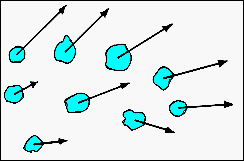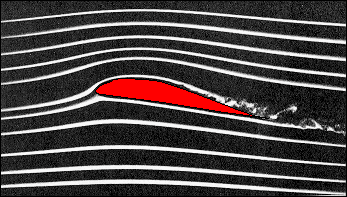| |
Fluid
Motion
In
order to understand how a fluid interacts with a solid object
moving through it, it will be necessary to explore how elements of the fluid
behave in its presence. The top diagram shows a number of fluid elements each
of which contain a large number of atoms. Each element has an arrow associated
with it that show the direction and magnitude of the particle speed. As
these elements move with the fluid, their speed may change.
The lower
photograph shows the flow around a model airfoil (red) in a wind tunnel. Smoke
streams have been added to the airflow and they follow its movement. The
smoke particles are analogous to the fluid elements shown in the top diagram.
The airfoil is slightly tilted (100) with respect to the mean
flow direction which is from left to right. It is seen that the flow starts
to be distorted before reaching the airfoil, and that after passing about half
way along the top of the airfoil the flow looses its "laminar" behavior
and starts to show a complicated "turbulent" region. The detailed
behavior of the flow will depend upon speed of the flow and the tilt angle
of the airfoil, its "angle of attack." |
|
|
|
|
|
|
|
|
|
|
|
|
|
|



